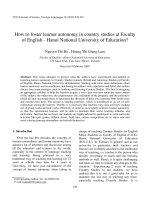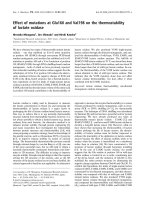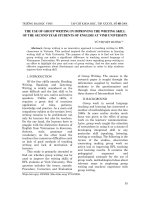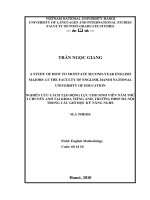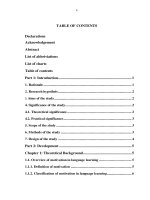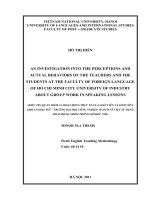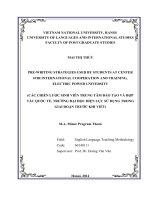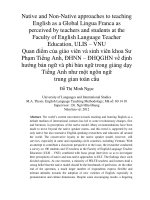Sight translation teaching methods used by lecturers at translator and interpreter training division faculty of english language teacher education
Bạn đang xem bản rút gọn của tài liệu. Xem và tải ngay bản đầy đủ của tài liệu tại đây (577.75 KB, 76 trang )
VIETNAM NATIONAL UNIVERSITY
UNIVERSITY OF LANGUAGES AND INTERNATIONAL STUDIES
FACULTY OF ENGLISH TEACHER EDUCATION
GRADUATION PAPER
SIGHT TRANSLATION TEACHING METHODS USED BY
LECTURERS AT TRANSLATOR AND INTERPRETER TRAINING
DIVISION, FACULTY OF ENGLISH LANGUAGE TEACHER
EDUCATION, UNIVERSITY OF LANGUAGES AND
INTERNATIONAL STUDIES, VIETNAM NATIONAL UNIVERSITY
AND THOSE AT ENGLISH DEPARTMENT, HANOI UNIVERSITY
Supervisor : Nguyen Ninh Bac M.A.
Student: Do Thu Hoai
Year of enrollment: QH2009
HANOI, 2013
ĐẠI HỌC QUỐC GIA HÀ NỘI
TRƯỜNG ĐẠI HỌC NGOẠI NGỮ
KHOA SƯ PHẠM TIẾNG ANH
KHOÁ LUẬN TỐT NGHIỆP
Các phương pháp giảng dạy dịch đọc được các giáo viên
ngành Biên phiên dịch, khoa Sư phạm tiếng Anh, trường
Đại học ngoại ngữ, ĐHQGHN và các giáo viên khoa
tiếng Anh, trường Đại học Hà Nội sử dụng
Giáo viên hướng dẫn: Th.S Nguyễn Ninh Bắc
Sinh viên: Đỗ Thu Hồi
Khố: QH2009
HÀ NỘI – NĂM 2013
ACCEPTANCE
I hereby state that: I, Đỗ Thu Hoài – Group 09.1.E25, being a candidate
for the degree of Bachelor of Art accept the requirements of the University
relating to the retention and use of Bachelor’s Graduation Paper deposited in
the library.
In terms of these conditions, I agree that the origin of my paper deposited
in the library should be accessible for the purposes of study and research, in
accordance with the normal conditions established by the librarian for the care,
loan or reproduction of the paper.
Signature
Hanoi, May 2013
i
ACKNOWLEDGEMENT
First and foremost, I wish to express my sincerest thank to my supervisor Mr.
Nguyễn Ninh Bắc, M.A. for his invaluable guidance, his great patience as well as his
considerable encouragement during the process of this research.
I would like to thank all six lecturers and the fourth year students in six classes
in ULIS and HANU, who were willing to give very detailed answers to my
questionnaires and
interviews.
Without their enthusiastic participation and
cooperation, this research would not have been completed.
I also would love to send my thanks to all my classmates, especially my three
best friends, Vũ Thị Kim Liên, Vương Thu Hằng, and Trần Thị Huyền Anh for their
supports in both materials and spirits. Their help always came on the right time when I
found discouraged and got troubles during the process of conducting this paper.
As well, I want to thank all managers and staffs in the Oxford English
Academy, Vietnam for their supports and sympathy. Without their support, I would
not have finished this paper.
Last but not least, I am grateful to my family for their support and
encouragement continuously from the beginning to the end of the research process.
ii
ABSTRACT
Translation and interpretation have been taught in a lot of universities in
Vietnam for many recent years. In the curriculums for translation and interpretation of
the Translation and Interpretation Division, English Teacher Education Department in
the University of Languages and International Studies, Vietnam National University
and the English Department, Hanoi University, sight translation is introduced via
different forms. As one of the first studies on sight translation teaching, this paper
aimed at investigating different types of sight translation exercises applied to teach
students of translation and interpretation major in the two universities. In order to
achieve this goal, the research used questionnaires and interviews to collect data.
Questionnaires were delivered to 132 students in ULIS and HANU. Interviews were
conducted with six lecturers from both universities.
Through data collection and analysis, eight different types of sight translation
exercises used by lecturers in ULIS and HANU were identified. The results show that
the number of exercise types used in ULIS is larger than that used in HANU. In
addition, lecturers in Translation and Interpretation Division of ULIS tend to design
more detailed and complex exercises for their students than those in English
Department, HANU. Because they are taught different exercise types, students in the
two universities also have different evaluation on the most effective type for them. As
this is the first research on sight translation teaching in ULIS and HANU, there are
some limitations, which gives opportunity for further researches in the futures. Some
recommendations are given in the last chapter of the paper.
iii
TABLE OF CONTENTS
ACCEPTANCE ........................................................................................................................................ i
ACKNOWLEDGEMENT ....................................................................................................................... ii
LIST OF ABBREVIATION....................................................................................................................vi
LIST OF TABLES AND FIGURES ......................................................................................................vii
CHAPTER 1: INTRODUCTION ............................................................................................................ 1
1.1.
Statement of the research and practical rationale for the study ............................................... 1
1.2.
Aims and objectives of the study ............................................................................................. 2
1.3.
Scope of the study ................................................................................................................... 2
1.4.
Significance of the study ......................................................................................................... 3
1.5.
The organization of the study .................................................................................................. 3
CHAPTER 2: LITERATURE REVIEW ................................................................................................. 2
2.1. Key concepts ................................................................................................................................ 5
2.1.1. Translation ............................................................................................................................. 5
2.1.2. Interpretation ......................................................................................................................... 7
2.1.3. Sight translation ..................................................................................................................... 8
2.2. Related studies ............................................................................................................................ 12
CHAPTER 3: METHODOLOGY ......................................................................................................... 16
3.1. Setting of the study ..................................................................................................................... 16
3.2. Sampling and participants .......................................................................................................... 17
3.2.1. Sampling method ................................................................................................................. 17
3.2.2. Participants .......................................................................................................................... 17
3.3. Research instruments .................................................................................................................. 19
3.3.1. Interview .............................................................................................................................. 19
3.3.2. Questionnaire ....................................................................................................................... 20
iv
3.4. Procedures .................................................................................................................................. 21
3.4.1. Data collection procedure .................................................................................................... 21
3.4.2. Data analysis procedures ..................................................................................................... 22
CHAPTER 4: FINDINGS AND DISCUSSION ................................................................................... 24
4.1. Research question 1: What kinds of exercises are applied to teach sight translation by lecturers
of the two divisions at the two universities?...................................................................................... 24
4.2. Research question 2: What methods of sight translation teaching do students of two divisions at
the two universities find most effective for them? Why do they find most effective? ...................... 31
4.2.1. At the University of Languages and International Studies .................................................. 31
4.2.2. At English Department, Hanoi University........................................................................... 33
4.3. Research question 3: What are the students’ suggestions to develop sight translation teaching?
........................................................................................................................................................... 35
4.4. Further discussion on sight translation exercises used in ULIS and HANU .............................. 36
CHAPTER 5: CONCLUSION .............................................................................................................. 38
5.1. Summary of major findings ........................................................................................................ 38
5.2. Contributions of the study .......................................................................................................... 40
5.3. Limitations of the study .............................................................................................................. 41
5.4. Suggestions for further studies ................................................................................................... 41
REFERENCES ...................................................................................................................................... 42
APPENDIX 1: INTERVIEW QUESTIONS ......................................................................................... 44
APPENDIX 2: QUESTIONNAIRE ...................................................................................................... 47
APPENDIX 3: INTERVIEW TRANSCRIPTS .................................................................................... 51
v
LIST OF ABBREVIATION
Consecutive interpreting
CI
English Department
ED
Faculty of English Language Teacher Education
FELTE
Hanoi University
HANU
Sight translation
ST
Simultaneous interpreting
SI
Translation and Interpretation Training Division
TITD
University of Languages and International Studies
ULIS
vi
LIST OF TABLES AND FIGURES
Name of table/ figure
Table 1: Comparison among sight translation and translation,
interpretation
Table 2: Elif Ersozlu’s exercises used in a sight translation course
(Elif, 2005)
Table 3: Number of lecturers and students
Table 4: Types of sight translation exercises designed by lecturers
from ULIS and HANU
Figure 1: ULIS student’s evaluation of sight translation exercises
Figure 2: HANU student’s evaluation of sight translation exercises
Figure 3: Students’ suggestions to improve sight translation teaching
vii
Page
10
14
18
24
32
34
35
CHAPTER 1: INTRODUCTION
This first chapter will provide the rationale, the aims and objectives, the
organization and significance of the research. In addition, the research questions will
be identified as the goals of the whole research.
1.1.
Statement of the research and practical rationale for the study
Together with the development of translation and interpreting occupation,
translation – interpreting teaching and learning has been given more attention in recent
years. There are numerous studies on translation – interpretation teaching and learning
all over the world while sight translation, which is also a form of translation, has not
been accorded due attention.
According to Agrifoglio (2004), “at the boundary between translation and
interpreting, sight translation appears as a hybrid and rather unexplored phenomenon,
used in various contexts and with different definitions” (p.43). In Vietnam, to my
knowledge, there is just one research carried by Ms. Hoang Thanh An on sight
translation study by fourth year students at Translation and Interpreting Division,
English Teacher Education Department, ULIS, VNU. However, the research only
provides results related to a small number of students and lecturers. In addition, they
are at only one university in Vietnam. In the study, sight translation methods have not
been analyzed deeply and comprehensively due to “the small sample size of
respondents” (Hoang, 2011, p.52).
Meanwhile, sight translation is very useful when practicing translation as well as
interpretation. In reality, interpreters and translators are required to sight-translate
documents in many different settings, for example, courtrooms, hospitals, business
services, and so on. “In job interviews, candidates are also asked to perform a sight
translation at a loud voice as a way to test their linguistic competence” (Visintin &
Campos, 2009, p.616).
1
All these conditions, henceforth, offered the researcher a chance to conduct a
study on “Sight translation teaching methods used by lecturers at Translator and
Interpreter Training Division, Faculty of English Language Teacher Education, ULIS,
VNU and those at English Department, HANU.”
1.2.
Aims and objectives of the study
The research aims at examining teaching methods applied to teach sight
translation at ULIS and HANU. The researcher also wishes to find out which methods
students of ULIS and HANU like most and why and offer some proposals to develop
those methods. In brief, the objectives mentioned above could be summarized into
three following research questions:
1. What kinds of exercises are applied to teach sight translation by lecturers of the two
divisions at the two universities?
2. What methods of sight translation teaching do students of two divisions at the two
universities like most? Why do they find them most effective?
3. What are the students’ suggestions to improve the methods that they like most?
1.3.
Scope of the study
As the aims of the research have been clearly stated previously, the researcher
pays great attention to sight translation teaching in the training curriculum of
translation and interpretation. The first and foremost concern of the study will be
different types of sight translation exercises used to teach students of translation and
interpretation major. In other words, while there are a lot of issues relating to sight
translation, the research only concentrates on the methods in which it is conveyed to
students and whether students find those methods effective for their translation and
interpretation skills or not.
2
In addition, it is necessary to note that the research is carried out in the contexts
of TITD, FELTE, ULIS, VNU and ED, HANU where sight translation is taught in the
curriculum. These are the two most famous and long-standing universities of
translation and interpretation training in Vietnam in general and in Hanoi in particular.
Finally, it is noteworthy that the samples in this study were restricted to
lecturers and forth year students at TITD, FELTE, ULIS, VNU and ED, HANU. Three
lecturers and three classes at each of the two divisions/ departments were chosen to
support the researcher to come up with final findings.
1.4.
Significance of the study
Once having been completed, the research would serve as one of the initial
studies on sight translation teaching method in Vietnam. Therefore, the paper might be
useful for firstly, lecturers of translation and interpreting and policy makers in the two
universities. It will provide them with a number of sight translation teaching methods.
Secondly, it might be helpful for students and those who develop an interest in the
topic. Finally, as aforementioned, the research will make a contribution to enriching
the scholarship on sight translation.
1.5.
The organization of the study
Apart from chapter 1, the rest of the study consists of the following chapters.
Chapter 2 (Literature review) provides a brief overview of the literature on the
research topic both over the world and in Vietnam. Comparisons will be made to
determine the research gaps. Consequently, the implementation of this study will be
justified.
Chapter 3 (Methodology) describes the sampling method, numbers and features of
participants, research instruments as well as the procedures of data collection and
analysis.
3
Chapter 4 (Results and Discussions) answers the four research questions mentioned
previously and presents some comparisons between the data analyzed and factual
findings.
Chapter 5 (Conclusion) summarizes the main points, states the conclusions, admits
the limitations and suggests for further studies.
4
CHAPTER 2: LITERATURE REVIEW
This chapter will provide a brief overview of the literature on the research topic,
thereby, laying the theoretical basis for the whole study. Firstly, a critical explanation
of key concepts such as translation, interpretation, and sight translation will be given.
Then, related studies not only in Vietnam, but also all over the world will be reviewed
to contextualize the research paper, and determine the research gaps. Consequently,
the implementation of this study will be justified.
2.1. Key concepts
2.1.1. Translation
The term translation conveys several different meanings; as a result, a lot of
definitions of translation can be found. There is no fixed definition because each
definition is proposed basing on different aspects of the term. Translation can be
understood as a process, which means the act of producing a translation or as a product
– the text that has been translated.
Solodub (cited in Sokolopsky 2010, p.286) defines that “translation is a specific
oral or written activity aimed at the recreation of an oral or written text (utterance)
existing in one language, accompanied by keeping the invariance of content, qualities
of the original and author’s authenticity.” The two words activity and recreation imply
that translation must be conducted through different steps.
Larson (1984, p.3) seems to be in agreement with Solodub at this point since in
his book, “Meaning-based translation: A guide to cross-language equivalence” he also
points out the steps required during translation process. According to him, translation
comprises three main steps: “studying” various elements of the source text (ST) such
as “lexicon, grammatical structure, communication situation, and cultural context”;
“analyzing” those elements to understand the text’s meaning; and “reconstructing” the
5
ST by using appropriate words, grammar structures in the target language’s context to
produce the target text (TT).
Banjar (2009) makes a comparison between a translator and a “message
conveyor” to create a foundation for her to explain translation as a process. She
emphasizes that “a translation may be understood as the process whereby a message
which is expresses in a particular source language is linguistically transformed in order
to be understood by readers of the target language. Actually, the translator is conveying
the meaning expressed by the original writer so the end reader gets a translated text
that is faithful to the source text in meaning.” Like Larson, to clarify her definition,
Banjar also gives out three phases of translation process. The first phase is analyzing
the ST – the text that needs to be transformed into another language. Then the second
phase starts when the translator transfers the source language into the target language
to achieve the target text (TT). Finally, revision of the translation is the last phase of
the translation process.
In the book, “Introduction into Theory of Translation”, Alekseeva (2004, p.7)
also defines translation as an activity. This activity “consists of variable re-expression,
converting of the text in one language into the text in a different language, which is
carried out by a translator, who creatively chooses variants depending on language
variability resources, type text, translation task, and under the influence of his/ her own
personal individuality.” (p.7) However, Alekseeva does not only consider translation
an activity, which can be understood as process, but also broadens his definition of
translation by defining translation as a result of the activity mentioned above.
Alekseeva’s definition is strongly supported by Semenov (cited in Sokolovsky, 2010)
that:
First of all, translation is the translator’s activity of transforming a
message with the same meaning in another language; secondly, translation is a
result of the translator’s activity, i.e. an oral or written language utterance.
(p.25)
6
The word result in Alekseeva and Semenov’s definitions is similar to the word
production in the following definition:
Translation is […] the production of a new, equivalent text in another language –
called the target text, or the translation, that communicates the same message.
(National Consultative Committee on Racism and Interculturalism, 2008, p.ix)
On the other hand, many linguistics and scholars define translation from a
different direction, which is neither process nor product. They regard translation as a
skill. This point of view is stated by Peter Newmark (1988) in Approaches to
translation that:
Translation is a craft consisting in the attempt to replace a written
message and/ or statement in one language by the same message and/ or
statement in another language. (p.7)
He also emphasizes that the messages or statements in both source language
and target language are in written form.
This research paper adopts the view of Newmark (2001, p.7) mentioned above.
Translation, as a result, is understood in a narrow meaning referring to a skill of
“rendering the meaning of a text into another language in the way that the author
intended the text” (Newmark, 1988, p.4).
2.1.2. Interpretation
The term interpretation, like the term translation, is also understood in different
ways basing on its different characteristics.
Collin and Morris (1996, p.xiii) refer the term interpretation to the process of
transforming a message expressed in one language (source language) to another
language (target language). At this point, interpretation is very similar to translation.
However, what distinguishes interpretation from translation is that in interpretation
7
“material presented orally is re-expressed orally.” In other words, both sourcelanguage text and target text-language text are spoken.
In a research conducted by Irish National Consultative Committee on Racism
and Interculturalism in 2008, interpretation is defined as “an activity that consists of
establishing, either simultaneously or consecutively, oral or gestural communications
between two or more speakers who are not able to use the same set of symbols or
language” (p.viii). Angelelli (2000, p. 180) also says that interpretation happens when
two interlocutors do not communicate in the same language in a cross-cultural
communication.
Kade (1968) (cited in Le & Nguyen 2008, p.18) seems to have the same idea
with Collin and Morris (1996). She defines interpretation as a form of translation
named oral-oral translation. It is explained in details that during the interpretation
process, the interpreter only listen to the input (source-language text) once and under
high pressure of time, has to produce the output (target-language text) very quickly.
There is little chance for interpreter to correct or revise his/ her interpretation.
Moreover, there is often no chance to review or replay the source-language text.
The research will use the definition given out by Kade (1968) above. As a
result, whenever the term interpretation is mentioned, it will be understood as a form
of translation in which both source and target languages are oral and target language is
produced under high time pressure.
2.1.3. Sight translation
2.1.3.1. Definition of sight translation
Like the terms translation and interpretation, sight translation is also
conceptualized in different ways. Various definitions can be found in different
documents. For example, Lambert (2004) says that:
Sight translation involves the transposition of a message written in one
language into a message delivered orally in another language. Since both oral
8
and visual forms of information processing are involved, sight translation can
be defined as a specific type of written translation as well as a variant of oral
interpretation (p.298).
From Lambert’s definition, it can be seen that in sight translation the sourcelanguage text is written form and the target-language text is in spoken form. In his
article, "Shared attention during sight translation, sight interpretation and simultaneous
interpretation", he also compares sight translation to sight interpretation and
simultaneous interpretation. He emphasizes that sight translation is “opposed to” sight
interpretation – “one step closer to simultaneous interpretation in that the message is
presented both aurally and visually” (p.299). Vezzi (cited in Lambert 2004) comments
that the process of sight translation, sight interpretation and simultaneous
interpretation are not as same as each other.
Agrifoglio (2004, p.1) stated that “at the boundary between translation and
interpreting, sight translation appears as a hybrid.” The explanation is given that
source text in sight translation is written (like in translation) but the target text is oral
(like in interpretation).
Epstein (2007) appears to be in agreement with Agrifoglio at this point because
in her article, “Sight translation”, she also calls sight translation “a combination of
translation and interpretation, of the visual and the vocal.” In her opinion, the
translator may or may not have time to prepare; however, it’s common that he/ she
gets the text, has to read and translate it aloud at the same time.
The National Council on Interpreting in Health Care (2009) defines sight
translation as follows:
Sight translation is the oral rendition of text written in one language into
another language and is usually done in the moment. (p.4)
In the document provided by this organization, sight translation is also
compared to written translation. The difference between them lies in their output.
While in written translation, the output is written, the output is in oral form in sight
9
translation. According to the Council, sight translation needs three main skills, which
are reading, speaking and speech production skills.
Sampaio (2003) considers sight translation oral translation, a form of translation
divided by Kade (n.d., cited in Le & Nguyen 2008, p.18). Sampaio says that in sight
translation, the form of text production is very special because the oral translation is
practically concurrent with the reading of the text. It means that from a written input in
the source language, after sight translation, a verbal output in the target language will
be achieved. Angelelli (cited in Sampaio 2003, p.65) adds up that “sight translation is
an oral translation of a written text that should sound as if the interpreter were merely
reading a document written in the target language.”
In the research, sight translation will be understood similarly to the definitions
given by Kade (1968), Sampaio (2003) and Angelelli (2003) mentioned in the above
paragraph. It is a form of translation with a written input and oral output. It is usually
used as a pedagogical method in teaching translation and interpretation.
2.1.3.2. Comparison among sight translation and translation, interpretation
Hoang (2011, p.14) makes a comparison among sight translation, translation
and interpretation, which shows their characteristics very apparently. Her comparison
is illustrated in the following table.
Table 1: Comparison among sight translation and translation, interpretation
Skills
Sight translation
Translation
Interpretation
- Reading skill
- Reading and
- Listening and
writing skills
speaking
skill(including public
- Cultural
skills(including
speaking)
knowledge
public speaking)
- Cultural knowledge
- Subject
- Cultural
- Subject knowledge
knowledge
knowledge
required - Speaking
10
(acquired before
(acquired before,
(acquired before
translation process)
in-stage and post-
translation
- Analytical skills
translation process)
process)
- Ethical
- Good ability to
- Subject
use the library of
knowledge
dictionaries and
(acquired before
reference materials
translation
- Analytical skills
process) - Good
- Ethical behavior
memory
- Note-taking
skills
Process
1.Reading for
1. Reading for
1. Listening and
understanding the text
understanding the
understanding the
in source language
text insource
text in source
2.Translatingmentally
language
language
3.Orally performing in
2. Translating
2. Interpreting
target language
3. Performing in
3. Orally
written form in
performing in
target language
target language
Table
2. Comparison
among sight
translation,
translation and
interpretation
The table once again shows that sight translation have many features in
common with translation as well as interpretation. The blended nature of sight
11
translation cause some controversies and inconsistencies when it is applied in the
training curriculum. The issue of when and to whom sight translation is suitable to be
taught remains questionable. In the book “Textologie und Translation”, Verlag (2003)
reviews some significant opinions of many scholars and researchers about sight
translation. According Verlag’s book, some researchers like Feal (1981) and Laplace
(1989) “recommend training in sight translation only after training in consecutive”
(cited in Verlag, 2003, p.273). Gile (1995) claims that sight transition exercises are not
suitable for beginners because “the constant presence off the SL text before their eyes
may increase the risk of interference” (. However, “Ilg depends the view that sight
translation should be introduced as early as possible in the training programme” (Ilg &
Lambert 1996, cited in Verlag 2003, p.273).
2.2. Related studies
While translation and interpretation have been the research topics for many
linguists as well as scholars around the world, it seems that little attention is paid to
sight translation. Therefore, it remains a relatively unexplored territory.
In the article “Shared attention during sight translation, sight interpretation and
simultaneous interpretation”, Lambert (2004, p.294-306) claims the types of
processing involved when subjects perform sight translation compared to both sight
interpretation and simultaneous interpretation. However, sight translation is not given
sufficient attention to in his research. Moreover, the results gained imply that sight
interpretation should be included in any cognitive approach to a simultaneousinterpreter training program.
Amparo Jiménez Ivars (n.d.), University Jaume I, conducted a research titled
“Sight translation and written translation: A comparative analysis of causes of
problems, strategies and translation errors within the PACTE translation competence
model”. The research proves that sight translation can be considered an interpreting
modality. In addition, it points out the nature of sight translation modality. Problems
12
and strategies used to solve them in sight translation and written translation are also
investigated in the research. Results reveal that more errors made in sight translation
than in in written translation.
Another comparative research is made to compare sight translation and
interpreting. In the work entitled “Sight translation and interpreting: A comparative
analysis of constraints and failures”, Agrifoglio (2004) describes sight translation by
putting it aside interpreting to compare. Sight translation is compared to both
simultaneous and consecutive interpreting. Results of the research give indications that
interpreters confront different difficulties and overcome those difficulties by various
efforts in each mode, sight translation or interpreting. Agrifoglio makes a conclusion
that “sight translation emerges as a complex and unique technique, whose cognitive
demands on the interpreter are by no means less than those of simultaneous and
consecutive.”
In 2009, Visintin and Campos carried out a research on sight translation;
however, they considered it as a cognitive tool in language learning. The work’s name
is “Sight translation as a cognitive tool in language learning.” According to the
researchers, it is certainly that sight translation is useful in learning language because it
can be used as a pedagogic strategy.
Notably, in the research “Mastering sight translation skills”, Sampaio (2003)
focuses much on sight translation scenarios. The research takes into account some
definitions as well as theoretical views about the nature of sight translation, the skills
and abilities it demands. In this research, sight translation teaching is discussed in
accordance with interpreter training program.
In Vietnam, sight translation has not been explored much. So far, there seems to have
been only one graduation paper by Hoang (2011) on this territory. The graduation
paper provides initial findings on the ways of teaching sight translation in Translator
and Interpreter Training Division, Faculty of English Teacher Education, Universities
of languages and International Studies. In addition, the research also presents
13
difficulties in performing sight translation and proposes some suggestions to overcome
those difficulties.
As the previous parts reveals, up to present, there is not many researches on
sight translation. Moreover, researches on sight translation exercises are rarer. Besides
the research carried by Ms. An Hoang Thanh above, Ersozlu (2005), lecturer at
Hacettepe University also conducted a study on sight translation exercises. The
research’s name is “Training of Interpreters: Some Suggestions on Sight Translation
Teaching”. In this research, Ersozlu provides six exercises to practice sight translation
in class. Actually, the six exercises follow a progress. They are about different skills,
not only sight translation. Actual sight translation activity only comes in the exercise
six. Those six exercises can be summarized in the table following:
Table 2: Elif Ersozlu’s exercises used in a sight translation course (Ersozlu, 2005)
Type of
Description
exercise
Exercise 1
Students go through three periods: They are given a text (250 -300
words). First, they scan. Then, they skim the text. Last, they are asked
comprehension questions after reading the text. The aim of this
exercise is to develop reading comprehension and fast reading skills.
Exercise 2
In the following weeks, the instructor chooses texts from various fields
and gives only the titles of the texts and asks students to use their
passive knowledge on the subject. Then, the instructor randomly
chooses keywords from the text and asks students to make logical
connections between those keywords and form a bold outline of the
text. The aim of this exercise is to enable the students to use their
passive knowledge and make logical connections between the facts.
Exercise 3
The same text used in the previous exercise will be used in this
14
exercise. This time, the students are asked to analyze the text in detail.
What is the type of the text? Is it informative? Is it vocative?...Those
questions will prepare the student for the translation process.
Exercise 4
In this exercise, students will have to practice:
-
Focusing on the message of the sentence/ paragraph rather than
the meaning of the word.
Exercise 5
Guessing the meaning of the word by using contextual clues
For this exercise, the students are handed out texts, which are written
in complex sentence structures. Then, they are asked to determine the
smallest semantic units in each sentence. The aim is not to use the
same grammatical structure but to give the same message in the target
language.
Exercise 6
This exercise will help students to focus on the meaning rather than the
structure and the words of a given text. The students are given texts
written in their native language and they are asked to "paraphrase"
each sentence.
Summary
The chapter explains three key concepts of the research, translation, interpretation, and
sight translation and provides readers with the studies related to sight translation
15
CHAPTER 3: METHODOLOGY
In the previous chapter, the literature on the research topic was briefly reviewed
for the theoretical basis of the whole study. Turning to the practical side, this research
is conducted with strict adherence to justify methods of data collection and analysis in
order to maximize its validity and reliability. This chapter provides the whole picture
of the methodology as the participants, the instruments (including questionnaires and
semi-structured interviews) as well as the procedures of data collection and analysis
are discussed in detail.
3.1. Setting of the study
The study was conducted at Translator and Interpreter Division, Faculty of
English Language Teacher Education, University of Languages and International
Studies, Vietnam National University in northern Vietnam (TITD, FELTE, ULIS,
VNU) and English Department, Hanoi University (ED, HANU). Being the two most
famous leaders in teaching translation and interpretation of Vietnam, the two
universities have applied many methods to improve the quality of training. Sight
translation is being taught in the curricula of the two universities as a supporting tool
for translation and interpreting training. Students at University of Languages and
International Studies are required to perform sight translation at the beginning their
translation and interpreting courses in the first semester of Year four. Sight translation
is considered as an official part of the translation and interpreting courses. In
translation course, teachers prepare sight translation exercises in accordance with the
themes in the curriculum and let students practice every two weeks. In interpreting
course, sight translation is introduced and taught to seniors in the first four weeks. At
Hanoi University, although sight translation is not considered as an official part of
translation or interpreting courses students still have chances to practice sight
translation when they are in the first semester or Year four. Translated texts of various
forms such as newspaper articles, interviews are still delivered to students to sight
16
